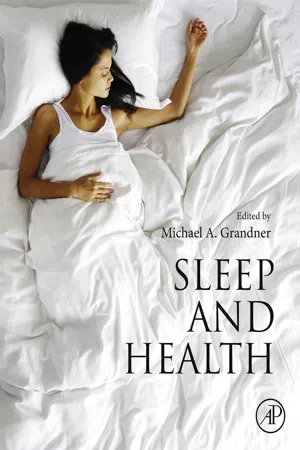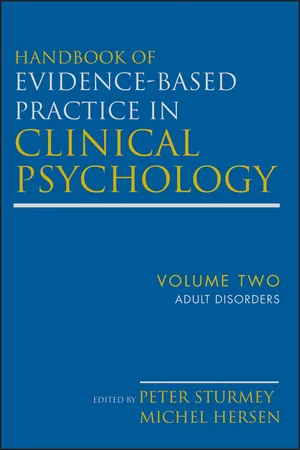Psychology
Sleep Disorders
Sleep disorders refer to a range of conditions that disrupt a person's normal sleep patterns. These can include insomnia, sleep apnea, narcolepsy, and restless legs syndrome, among others. These disorders can lead to significant impairment in daily functioning, impacting mood, cognitive abilities, and overall health. Treatment typically involves a combination of behavioral changes, therapy, and in some cases, medication.
Written by Perlego with AI-assistance
Related key terms
5 Key excerpts on "Sleep Disorders"
- eBook - ePub
Psychopathology
History, Diagnosis, and Empirical Foundations
- W. Edward Craighead, David J. Miklowitz, Linda W. Craighead(Authors)
- 2017(Publication Date)
- Wiley(Publisher)
Chapter 9Sleep‐Wake DisordersLu Dong Jennifer C. Kanady Allison G. HarveyWe spend approximately one third of our lives sleeping. Although the study of human sleep is a relatively young science and many fascinating mysteries remain to be solved, there have been great advances in knowledge about the function of sleep. For example, it is increasingly evident that sleep has a critical role in many domains of health (Zee & Turek, 2006) and psychological functioning (Walker & Stickgold, 2006). Great advances in knowledge have also been made relating to the nature and treatment of Sleep Disorders. Moreover, sleep disturbance is a characteristic of psychiatric disorders and, as we discuss below, can play a critical role in the maintenance of several disorders (Harvey, 2008a). In this chapter we focus on insomnia, as it is the most common sleep disorder.Insomnia is a chronic difficulty that involves a predominant complaint of dissatisfaction with sleep quantity or quality, accompanied by problems in getting to sleep, maintaining sleep, or early awakening with an inability to return to sleep (American Psychiatric Association [APA], 2013). It is a prevalent problem, reported by approximately 10% of the population (Ohayon & Reynolds, 2009; Roth et al., 2011). The consequences are severe and may include impairments in the quality of life (Léger et al., 2012), poor cognitive performance in such areas as concentration and memory (Fortier‐Brochu, Beaulieu‐Bonneau, Ivers, & Morin, 2012), higher rates of work absenteeism, decreased job performance, increased rates of work‐related accidents, and increased use of medical services (Léger, Guilleminault, Bader, Lévy, & Paillard, 2002). Sleep deprivation has detrimental effects on many domains of health (Zee & Turek, 2006), including the immune system, the neuroendocrine system, and the cardiovascular system (Dinges, Rogers, & Baynard, 2005). Given the prevalence and associated impairments, the cost of Sleep Disorders to society is enormous (Martin, Aikens, & Chervin, 2004). - eBook - ePub
Selecting Effective Treatments
A Comprehensive, Systematic Guide to Treating Mental Disorders
- Lourie W. Reichenberg, Linda Seligman(Authors)
- 2016(Publication Date)
- Wiley(Publisher)
Sleep is an important part of overall mental and physical health for people of all ages. Difficulty sleeping can become a chronic condition that interacts with other medical conditions and puts people at increased risk for depression, hypertension, and cardiovascular disease, including first time myocardial infarction (Bonnet & Arand, 2010). Therapists can play a crucial role in helping people improve the quality and quantity of sleep by providing psychoeducation about good sleep hygiene, environmental variables that impact sleep, and treating mental health problems that exacerbate, or result from, sleep difficulties.DSM-5 includes a new classification for Sleep-Wake Disorders, which contains the same basic subtypes of Sleep Disorders as DSM-IV, with some modifications. Many sections have been expanded (e.g., breathing-related Sleep Disorders) and others have been removed (e.g., Sleep Disorders related to a medical condition or another mental disorder). Another major change in the diagnosis of Sleep Disorders is the criteria that requires polysomnography and other scientific studies for many of the sleep-wake disorders including sleep apnea and hypopnea, restless legs syndrome, and narcolepsy.The sleep-wake disorders in DSM-5 include:- Insomnia disorder
- Hypersomnolence disorder
- Narcolepsy
- Breathing-related sleep disorder
- Parasomnias
- Non-rapid eye movement sleep arousal disorder
- Nightmare disorder
- Rapid eye movement sleep behavior disorder
- Restless legs syndrome
- Substance/medication-induced sleep disorder
- Other specified and unspecified sleep-wake disorders
Insomnia Disorder
Difficulty falling or staying asleep is the hallmark of this disorder. The resulting lack of sleep results in daytime sleepiness for 10% to 15% of adults, of which 6% to 10% meet the criteria for insomnia disorder.Complaints of not being able to fall asleep, stay asleep, or fall back to sleep are common and make insomnia disorder the most prevalent of the sleep-wake disorders. Symptoms must include at least one of the following three problems: (1) difficulty falling asleep, (2) difficulty staying asleep, as evidenced by frequent awakenings, or (3) early-morning awakening without being able to return to sleep. Symptoms must be present at least 3 nights a week for a minimum of 3 months. As with all of the Sleep Disorders, the symptoms cause clinically significant impairment in the ability to function during the day and may impact ability to work, drive a car, or other important areas of functioning. - Andrew Green, Cary Brown(Authors)
- 0(Publication Date)
- Jessica Kingsley Publishers(Publisher)
7 Sleep Disorders Andrew Green and Dietmar Hank 7.1 IntroductionPeople are seldom likely to be referred to occupational therapists for Sleep Disorders alone, although many patients with other conditions also have sleep difficulties, and in order to help manage such difficulties, and to know when to refer, it is important to have an understanding of Sleep Disorders. Essentially, Sleep Disorders can be categorized as insufficient sleep (insomnia), too much sleep (hypersomnia or excessive daytime sleepiness), unusual behaviours in sleep (parasomnia), sleeping at the wrong time (circadian-rhythm disorders) and movement disorders in sleep. Most Sleep Disorders are managed by either medication or cognitive and behavioural strategies, or a combination of these approaches. For example, in the case of insomnia the more effective long-term management is cognitive behavioural therapy for insomnia, whereas in the case of narcolepsy, medication is often effective and there is less emphasis on behavioural management. This chapter explores the major Sleep Disorders and outlines the principles of their management, but it is not intended as a guide to treatment of Sleep Disorders. The next chapter focuses on the non-pharmacological management of some insomnia and excessive daytime sleepiness. (For a concise but full guide to Sleep Disorders see Wilson and Nutt 2013, or for more detailed information see, for example, Avidan and Zee 2011.)7.2 InsomniaThe most common sleep problem is insomnia, which affects about 10–15% of the population (Wilson and Nutt 2013). It is defined as complaints of disturbed sleep in the presence of adequate opportunity and circumstance for sleep. The disturbance may consist of one or more of three features: (1) difficulty in initiating sleep; (2) difficulty in maintaining sleep; or (3) waking up too early. A fourth characteristic, non-restorative or poor-quality sleep, has frequently been included in the definition, although there is controversy as to whether individuals with this complaint share similar pathophysiological mechanisms with the others (NIH 2005, p.5).- eBook - ePub
- Michael A. Grandner, Michael Grandner(Authors)
- 2019(Publication Date)
- Academic Press(Publisher)
Part VII Public health implications of Sleep DisordersPassage contains an image
Chapter 28Insomnia and psychiatric disorders
Ivan Vargasa , b ; Sheila N. Garlandc , d ; Jacqueline D. Klossa ; Michael L. Perlisa , ba Behavioral Sleep Medicine Program, University of Pennsylvania, Philadelphia, PA, United Statesb Center for Sleep and Circadian Neurobiology, University of Pennsylvania, Philadelphia, PA, United Statesc Department of Psychology, Faculty of Science, Memorial University, St. John’s, NL, Canadad Division of Oncology, Faculty of Medicine, Memorial University, St. John’s, NL, CanadaAbstract
Insomnia was originally considered a symptom of psychiatric morbidity and not a separate form of disease. It was not until recently that sleep continuity disturbance (i.e., insomnia) was wholly recognized as an independent disorder. The impetus for this change in classification is related to a variety of factors including multiple demonstrations that chronic insomnia: (1) appears to have a unique etiology and pathophysiology; (2) occurs prior to, and represents a risk factor for, new onset and recurrence of multiple psychiatric disorders; (3) often persists following the successful treatment of the comorbid disorder(s); and (4) CBT-I (the indicated treatment for insomnia) may serve to augment standard treatment outcomes for other disorders (e.g., major depression). The clear implication is that, when chronic, insomnia should be targeted for treatment, regardless of the psychiatric disorders that occur concurrently. The goal of the present chapter is to review each of these issues in detail. - Michel Hersen, Peter Sturmey(Authors)
- 2012(Publication Date)
- Wiley(Publisher)
Chapter 19
Sleep Disorders in Adults
ALLISON G. HARVEY AND NATASHA DAGYSOVERVIEW OF DISORDER
Diagnostic Criteria
Insomnia is characterized by an ongoing difficulty getting to sleep, staying asleep, waking up too early, or waking up and feeling that the sleep obtained was not restorative. In addition to the sleep complaint, the individual with insomnia must report daytime impairment (Edinger et al., 2004). Four classification systems offer specific diagnostic criteria for insomnia. The Diagnostic and Statistical Manual (4th ed., text rev.) (DSM-IV-TR) (American Psychiatric Association, 2000) and the International Classification of Diseases (10th rev.) (ICD-10) (World Health Organization, 1992) offer a small number of broad categories based on current symptoms and functioning. In contrast, the Research Diagnostic Criteria (RDC) (Edinger et al., 2004) and the International Classification of Sleep Disorders (2nd ver.) (ICSD-2) (American Academy of Sleep Medicine, 2005) offer a larger number of subtypes that require the assessor to make judgments about the causes of the insomnia. Research is needed to resolve the differences between the four nomenclatures and to determine the validity and reproducibility of both the broad categories and the subtypes.It is important to note that in the past insomnia that is comorbid with another psychiatric disorder was referred to as secondary insomnia. Given the accruing evidence indicating that insomnia is an important but underrecognized mechanism in the multifactorial cause and maintenance of psychiatric disorders (A. G. Harvey, 2008; National Institutes of Health, 2005; Smith, Huang, & Manber, 2005), current standards recommend that insomnia be considered a comorbid
Learn about this page
Index pages curate the most relevant extracts from our library of academic textbooks. They’ve been created using an in-house natural language model (NLM), each adding context and meaning to key research topics.




